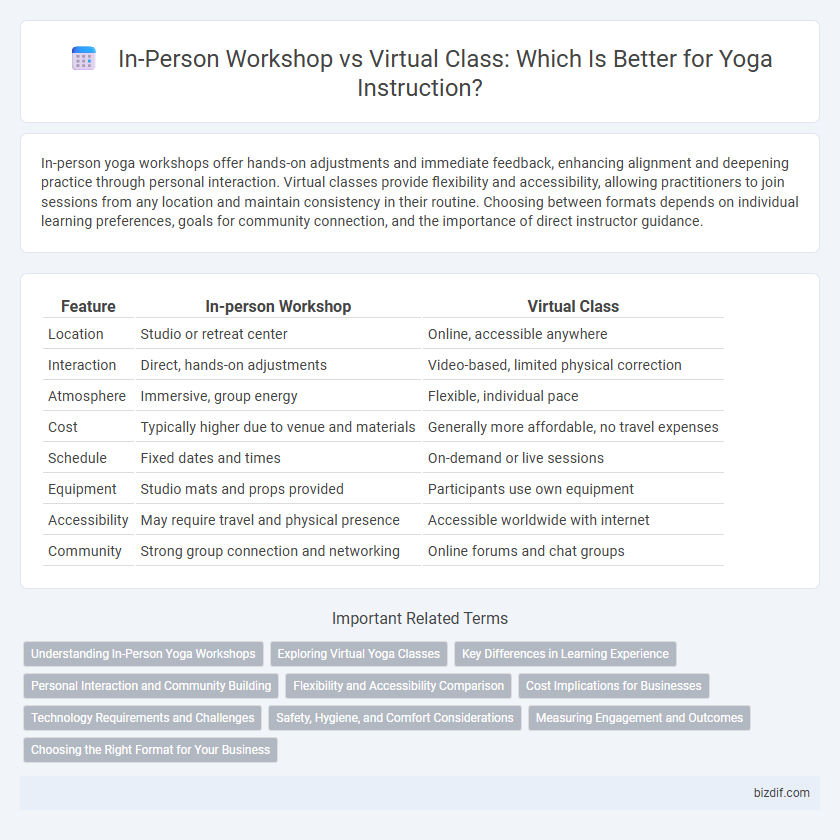In-person yoga workshops offer hands-on adjustments and immediate feedback, enhancing alignment and deepening practice through personal interaction. Virtual classes provide flexibility and accessibility, allowing practitioners to join sessions from any location and maintain consistency in their routine. Choosing between formats depends on individual learning preferences, goals for community connection, and the importance of direct instructor guidance.
Table of Comparison
| Feature | In-person Workshop | Virtual Class |
|---|---|---|
| Location | Studio or retreat center | Online, accessible anywhere |
| Interaction | Direct, hands-on adjustments | Video-based, limited physical correction |
| Atmosphere | Immersive, group energy | Flexible, individual pace |
| Cost | Typically higher due to venue and materials | Generally more affordable, no travel expenses |
| Schedule | Fixed dates and times | On-demand or live sessions |
| Equipment | Studio mats and props provided | Participants use own equipment |
| Accessibility | May require travel and physical presence | Accessible worldwide with internet |
| Community | Strong group connection and networking | Online forums and chat groups |
Understanding In-Person Yoga Workshops
In-person yoga workshops offer tactile adjustments, immediate feedback, and a shared energy that virtual classes often lack, enhancing alignment accuracy and deepening practice. These workshops enable hands-on guidance from experienced instructors in real-time, fostering a supportive community atmosphere crucial for motivation and growth. Engaging physically in a dedicated space reduces distractions, allowing practitioners to immerse fully and connect with their bodies on a deeper level.
Exploring Virtual Yoga Classes
Virtual yoga classes offer flexible scheduling and accessibility, allowing participants to join sessions from any location with an internet connection. Advanced streaming technologies provide real-time guidance and interactive feedback, enhancing the immersive experience of guided yoga practice. Virtual platforms often include a variety of class styles, durations, and skill levels, catering to individualized wellness goals and broadening the reach of expert instructors.
Key Differences in Learning Experience
In-person yoga workshops offer tactile adjustments and immediate feedback, enhancing alignment and personalized corrections that virtual classes cannot replicate. Virtual classes provide flexibility and accessibility, allowing learners to practice anytime and anywhere but may lack the immersive group energy and direct instructor interaction found in physical settings. The tactile and spatial awareness gained in face-to-face sessions significantly benefits beginners seeking hands-on guidance, while virtual formats suit advanced practitioners comfortable with self-cueing.
Personal Interaction and Community Building
In-person yoga workshops foster deep personal interaction through hands-on adjustments and real-time feedback, enhancing alignment and technique precision. These settings encourage organic community building via shared energy and face-to-face conversations, strengthening connections among participants. Virtual classes offer convenience but often lack the tactile guidance and spontaneous social bonding essential for immersive communal experiences.
Flexibility and Accessibility Comparison
In-person yoga workshops offer direct, hands-on guidance and a focused environment, ideal for those seeking personalized adjustments and community interaction. Virtual yoga classes provide unmatched flexibility and accessibility, allowing practitioners to join sessions from any location and at various times, accommodating diverse schedules. Both formats enhance yoga practice, but virtual classes significantly broaden access for individuals with time constraints or limited local studio options.
Cost Implications for Businesses
In-person yoga workshops often involve higher costs for businesses due to venue rental, equipment, and staff expenses, whereas virtual classes significantly reduce overhead by eliminating physical space and travel requirements. Virtual platforms require investment in reliable technology and streaming services but offer scalability that can increase profitability with lower marginal costs per participant. Businesses must weigh these cost implications against client engagement and retention to determine the most sustainable delivery method.
Technology Requirements and Challenges
In-person yoga workshops require minimal technology, focusing mainly on physical props and space, while virtual classes depend heavily on reliable internet connectivity, quality cameras, and sound equipment to ensure clear communication. Technical challenges such as latency, software glitches, and device compatibility can disrupt the flow and engagement in virtual sessions. Managing these technology requirements effectively is crucial to delivering a seamless yoga experience and maintaining participant satisfaction in online formats.
Safety, Hygiene, and Comfort Considerations
In-person yoga workshops allow instructors to closely monitor participants' postures, reducing injury risk and ensuring personalized adjustments for enhanced safety. Hygienic protocols, including sanitized mats and controlled studio airflow, are critical to minimize germ transmission in physical settings. Virtual classes offer comfort and flexibility by enabling practice in one's own space, though they require self-discipline to maintain proper form and safety during sessions.
Measuring Engagement and Outcomes
Measuring engagement in in-person yoga workshops often relies on direct observation of participants' posture, breath control, and interaction, providing immediate feedback on practice quality. Virtual classes utilize analytics such as attendance rates, screen time, and real-time polling to assess participant involvement, though they may lack nuanced physical cues. Outcome evaluation combines self-reported wellness improvements and instructor assessments, with in-person settings facilitating hands-on adjustments and virtual formats emphasizing digital engagement metrics for comprehensive insight.
Choosing the Right Format for Your Business
Choosing between in-person workshops and virtual classes depends on your target audience's preferences and your business goals. In-person workshops foster deeper community engagement and hands-on adjustments, enhancing personalized instruction and client retention. Virtual classes offer flexibility, broader reach, and lower overhead costs, making them ideal for scaling your yoga business globally.
In-person Workshop vs Virtual Class Infographic

 bizdif.com
bizdif.com